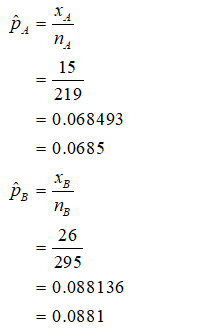A researcher is studying two types of medication that both treat hives. 15 out of the random sample of 219 adults given medication A still had hives 30 minutes after taking the medication. 26 out of another random sample of 295 adults given medication B still had hives 30 minutes after taking the medication. Test to see if the proportion of people who still had hives after medicine A is different than the proportion of people who still had hives after medicine B. Use a 0.01 level of significance.
A researcher is studying two types of medication that both treat hives. 15 out of the random sample of 219 adults given medication A still had hives 30 minutes after taking the medication. 26 out of another random sample of 295 adults given medication B still had hives 30 minutes after taking the medication. Test to see if the proportion of people who still had hives after medicine A is different than the proportion of people who still had hives after medicine B. Use a 0.01 level of significance.
MATLAB: An Introduction with Applications
6th Edition
ISBN:9781119256830
Author:Amos Gilat
Publisher:Amos Gilat
Chapter1: Starting With Matlab
Section: Chapter Questions
Problem 1P
Related questions
Topic Video
Question

Transcribed Image Text:A researcher is studying two types of medication that both treat hives. 15 out of the random sample of 219
adults given medication A still had hives 30 minutes after taking the medication. 26 out of another random
sample of 295 adults given medication B still had hives 30 minutes after taking the medication. Test to see
if the proportion of people who still had hives after medicine A is different than the proportion of people
who still had hives after medicine B. Use a 0.01 level of significance.
The correct hypotheses are:
O Ho:PA < PB
НА:РА > Рв(claim)
Ο Η: pA Σ ΡΒ
На: РА < Рв(claim)
O Ho:PA = PB
HA:PA + PB(Cclaim)
Since the level of significance is 0.01 the critical value is 2.576 and -2.576
The test statistic is:
(round to 3 places)
The p-value is:
(round to 3 places)
The decision can be made to:
O reject Ho
O do not reject Ho
The final conclusion is that:
O There is enough evidence to reject the claim that the proportion of people who still had hives after
medicine A is different than the proportion of people who still had hives after medicine B.
O There is not enough evidence to reject the claim that the proportion of people who still had hives
after medicine A is different than the proportion of people who still had hives after medicine B.
O There is enough evidence to support the claim that the proportion of people who still had hives after
medicine A is different than the proportion of people who still had hives after medicine B.
O There is not enough evidence to support the claim that the proportion of people who still had hives
after medicine A is different than the proportion of people who still had hives after medicine B.
Expert Solution
Step 1
Null and alternative hypothesis:

Correct answer is option (3)

The sample proportions are,

Step by step
Solved in 3 steps with 6 images

Knowledge Booster
Learn more about
Need a deep-dive on the concept behind this application? Look no further. Learn more about this topic, statistics and related others by exploring similar questions and additional content below.Recommended textbooks for you

MATLAB: An Introduction with Applications
Statistics
ISBN:
9781119256830
Author:
Amos Gilat
Publisher:
John Wiley & Sons Inc

Probability and Statistics for Engineering and th…
Statistics
ISBN:
9781305251809
Author:
Jay L. Devore
Publisher:
Cengage Learning

Statistics for The Behavioral Sciences (MindTap C…
Statistics
ISBN:
9781305504912
Author:
Frederick J Gravetter, Larry B. Wallnau
Publisher:
Cengage Learning

MATLAB: An Introduction with Applications
Statistics
ISBN:
9781119256830
Author:
Amos Gilat
Publisher:
John Wiley & Sons Inc

Probability and Statistics for Engineering and th…
Statistics
ISBN:
9781305251809
Author:
Jay L. Devore
Publisher:
Cengage Learning

Statistics for The Behavioral Sciences (MindTap C…
Statistics
ISBN:
9781305504912
Author:
Frederick J Gravetter, Larry B. Wallnau
Publisher:
Cengage Learning

Elementary Statistics: Picturing the World (7th E…
Statistics
ISBN:
9780134683416
Author:
Ron Larson, Betsy Farber
Publisher:
PEARSON

The Basic Practice of Statistics
Statistics
ISBN:
9781319042578
Author:
David S. Moore, William I. Notz, Michael A. Fligner
Publisher:
W. H. Freeman

Introduction to the Practice of Statistics
Statistics
ISBN:
9781319013387
Author:
David S. Moore, George P. McCabe, Bruce A. Craig
Publisher:
W. H. Freeman